Abstract
The metabolism of serotonin was studied in cancer patients of their first day of their first course of chemotherapeutic drugs either with strongly or moderately emetogenic regimens. It was observed that strongly emetogenic treatments induce greater increases in serotonin release than moderately emetogenic regimens. High-dose cisplatinum (75 +/- 5 or 83.8 +/- 5 mg m-2) produced a marked increase in the plasma levels and in the urinary excretion of 5-hydroxyindole acetic acid (5-HIAA). Neither platelet nor plasma (platelet-free plasma) serotonin were significantly modified by high-dose cisplatinum. Dacarbazine (283 +/- 22 mg m-2), another strongly emetogenic agent, induced acute nausea and emesis paralleled by marked increases in the urinary excretion of 5-HIAA. Both for high-dose cisplatinum and dacarbazine, the increases in serotonin metabolism occurred with a similar time-course than those of vomiting, and lasted for a period of 4 to 8 h. Low-dose cisplatinum (30.8 +/- 3 mg m-2) as well as cyclophosphamide-based chemotherapies (520 +/- 30 mg m-2) produced very small increases in the urinary excretion of 5-HIAA. Platelet and plasma serotonin levels failed to increase in cyclophosphamide-treated patients. Octreotide, a long-acting somatostatin analog, did not inhibit the increase in urinary 5-HIAA and the nausea and vomiting produced by high-dose cisplatinum. These results suggest that for treatments that induce marked increases in serotonin release such as high-dose cisplatinum or dacarbazine: (a) the amount and time course of serotonin release induced by chemotherapeutic drugs determines the severity, time of onset and pattern of emesis observed; (b) platelet serotonin play no role in chemotherapy-induced emesis; (c) strongly emetogenic regimens release serotonin from enterochromaffin cells; and (d) intestinal release of serotonin is the consequence of the damage induced by the chemotherapeutic drugs on the gut mucosa.
Full text
PDF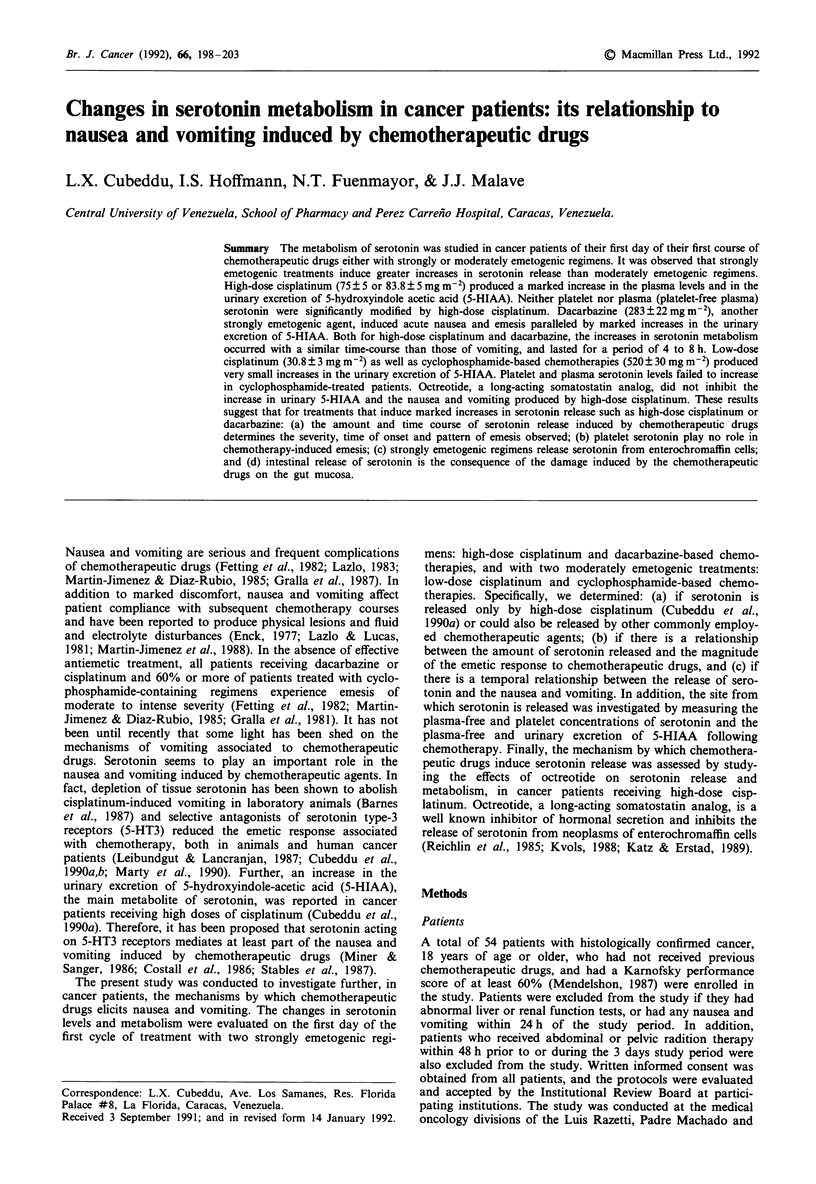
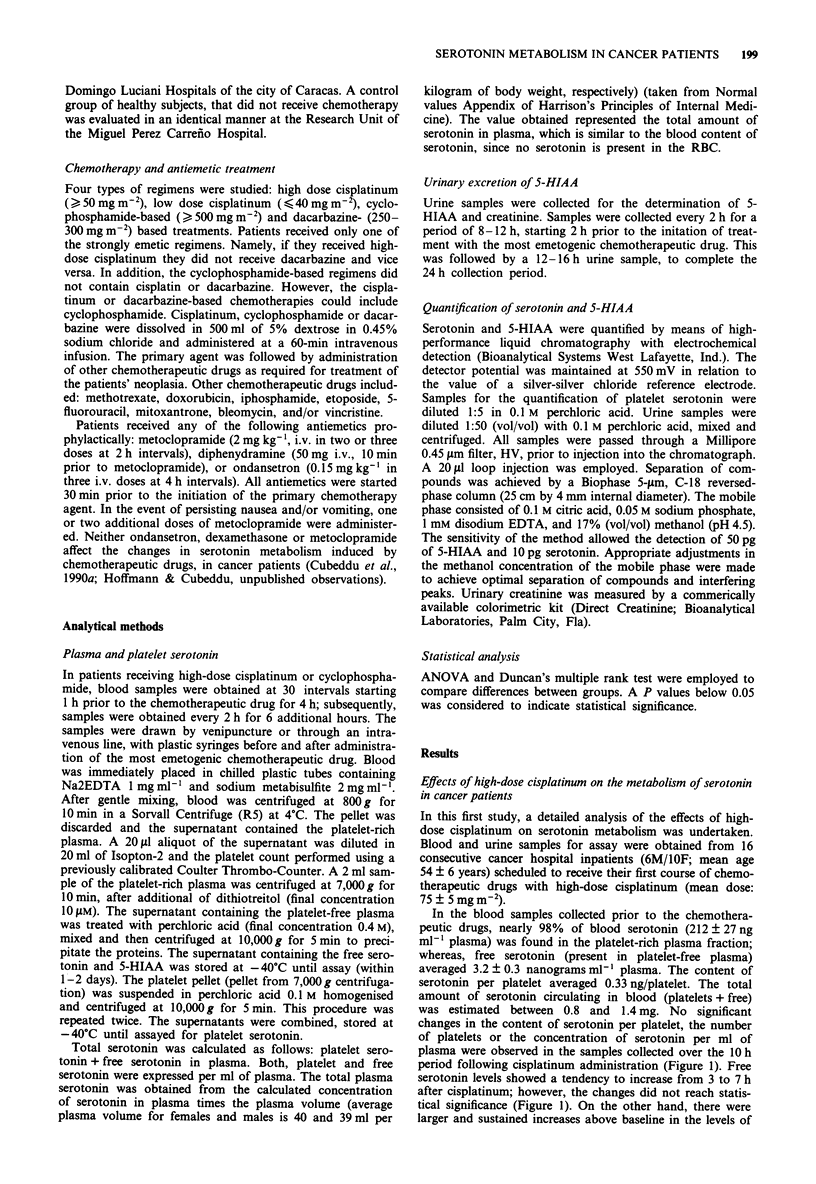
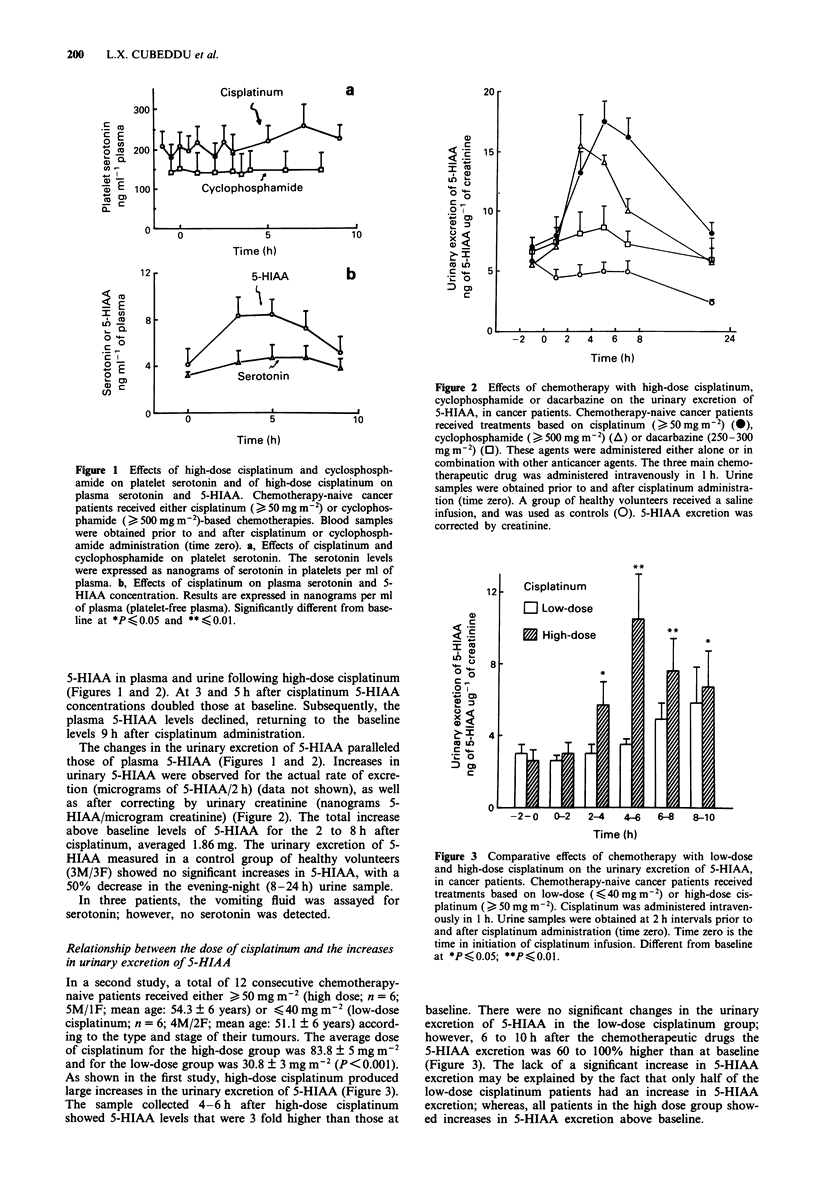
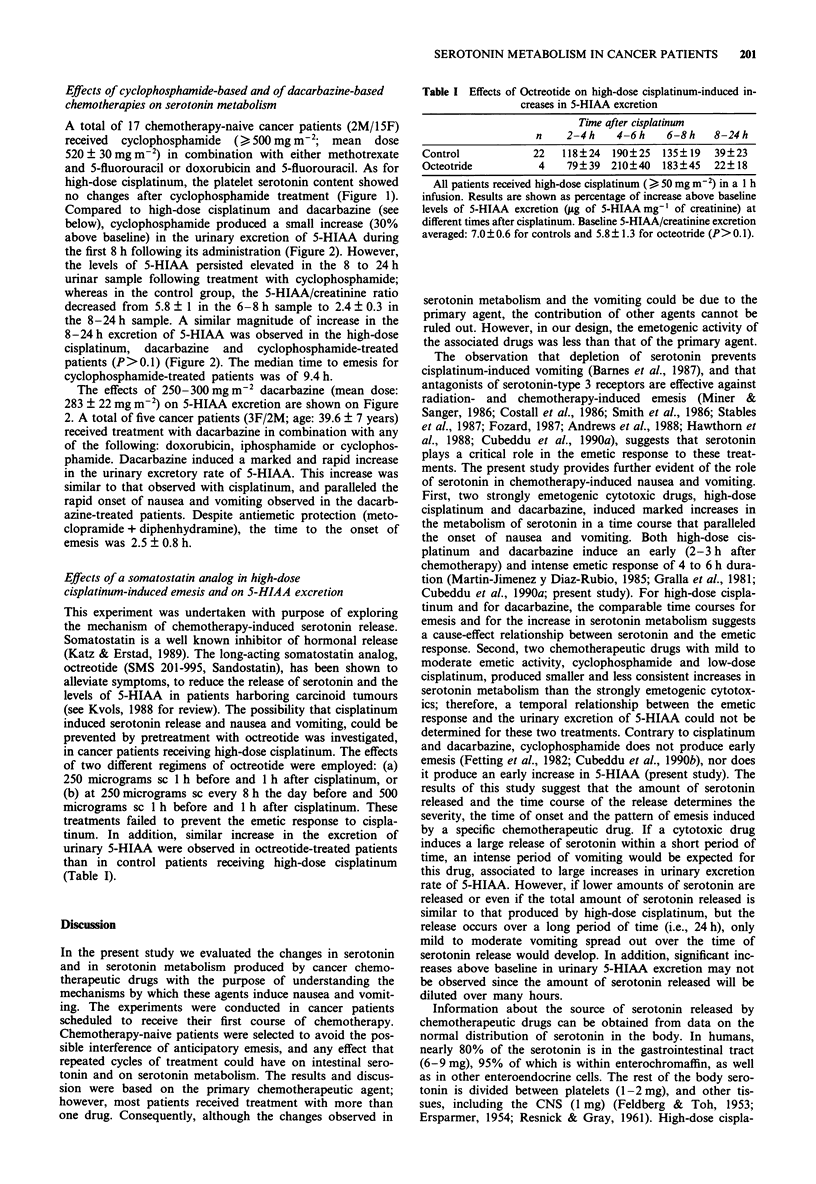
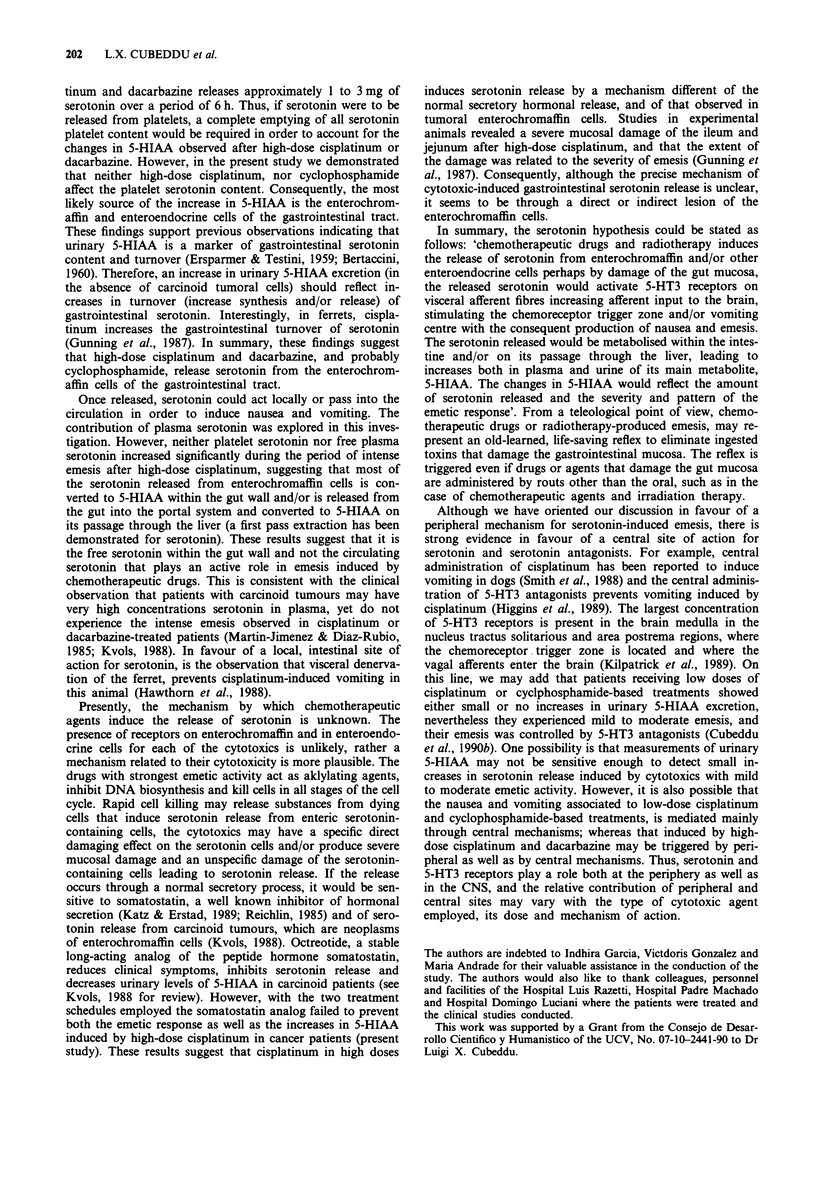
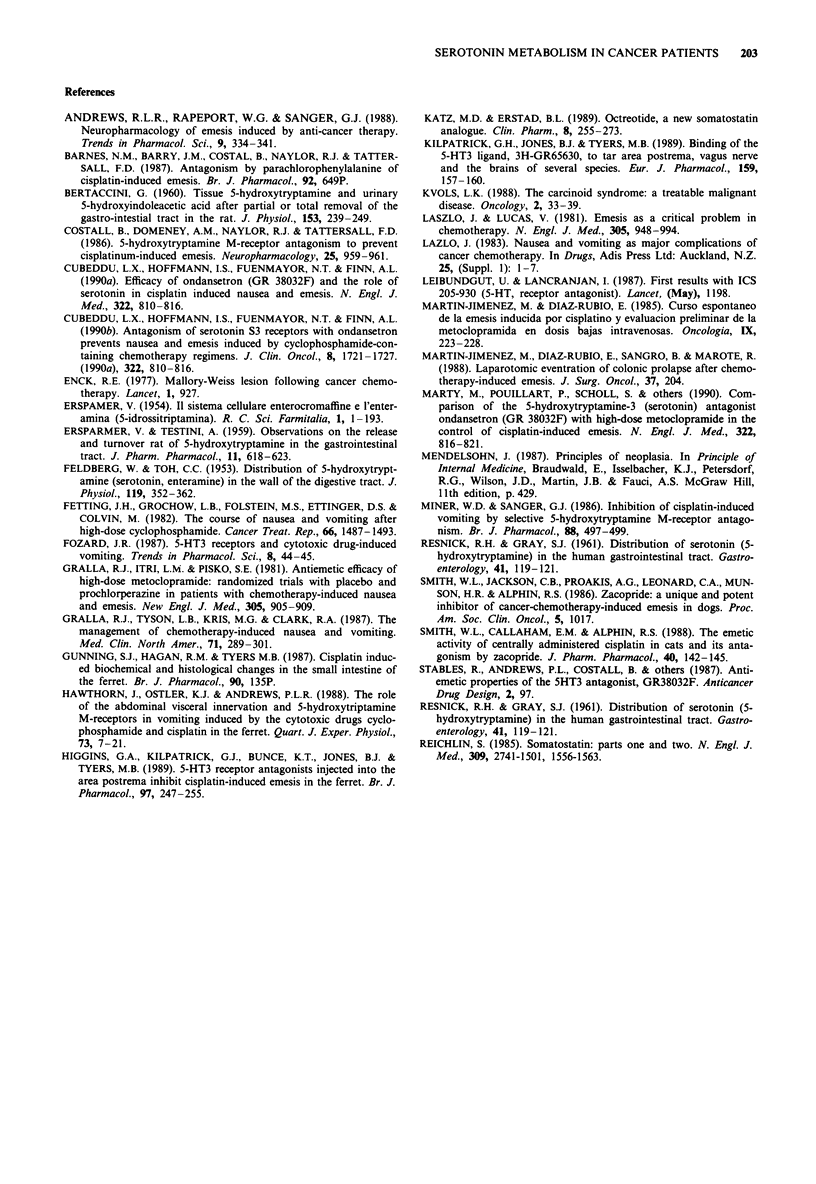
Selected References
These references are in PubMed. This may not be the complete list of references from this article.
- Andrews P. L., Rapeport W. G., Sanger G. J. Neuropharmacology of emesis induced by anti-cancer therapy. Trends Pharmacol Sci. 1988 Sep;9(9):334–341. doi: 10.1016/0165-6147(88)90106-x. [DOI] [PubMed] [Google Scholar]
- Bertaccini G. Tissue 5-hydroxytryptamine and urinary 5-hydroxyindoleacetic acid after partial or total removal of the gastro-intestinal tract in the rat. J Physiol. 1960 Sep;153(2):239–249. doi: 10.1113/jphysiol.1960.sp006532. [DOI] [PMC free article] [PubMed] [Google Scholar]
- Costall B., Domeney A. M., Naylor R. J., Tattersall F. D. 5-Hydroxytryptamine M-receptor antagonism to prevent cisplatin-induced emesis. Neuropharmacology. 1986 Aug;25(8):959–961. doi: 10.1016/0028-3908(86)90030-4. [DOI] [PubMed] [Google Scholar]
- Cubeddu L. X., Hoffman I. S., Fuenmayor N. T., Finn A. L. Antagonism of serotonin S3 receptors with ondansetron prevents nausea and emesis induced by cyclophosphamide-containing chemotherapy regimens. J Clin Oncol. 1990 Oct;8(10):1721–1727. doi: 10.1200/JCO.1990.8.10.1721. [DOI] [PubMed] [Google Scholar]
- Cubeddu L. X., Hoffmann I. S., Fuenmayor N. T., Finn A. L. Efficacy of ondansetron (GR 38032F) and the role of serotonin in cisplatin-induced nausea and vomiting. N Engl J Med. 1990 Mar 22;322(12):810–816. doi: 10.1056/NEJM199003223221204. [DOI] [PubMed] [Google Scholar]
- ERSPAMER V., TESTINI A. Observations on the release and turnover rate of 5-hydroxytryptamine in the gastrointestinal tract. J Pharm Pharmacol. 1959 Oct;11:618–623. doi: 10.1111/j.2042-7158.1959.tb12603.x. [DOI] [PubMed] [Google Scholar]
- Enck R. E. Mallory-Weiss lesion following cancer chemotherapy. Lancet. 1977 Oct 29;2(8044):927–928. doi: 10.1016/s0140-6736(77)90858-3. [DOI] [PubMed] [Google Scholar]
- FELDBERG W., TOH C. C. Distribution of 5-hydroxytryptamine (serotonin, enteramine) in the wall of the digestive tract. J Physiol. 1953 Feb 27;119(2-3):352–362. doi: 10.1113/jphysiol.1953.sp004850. [DOI] [PMC free article] [PubMed] [Google Scholar]
- Fetting J. H., Grochow L. B., Folstein M. F., Ettinger D. S., Colvin M. The course of nausea and vomiting after high-dose cyclophosphamide. Cancer Treat Rep. 1982 Jul;66(7):1487–1493. [PubMed] [Google Scholar]
- Gralla R. J., Itri L. M., Pisko S. E., Squillante A. E., Kelsen D. P., Braun D. W., Jr, Bordin L. A., Braun T. J., Young C. W. Antiemetic efficacy of high-dose metoclopramide: randomized trials with placebo and prochlorperazine in patients with chemotherapy-induced nausea and vomiting. N Engl J Med. 1981 Oct 15;305(16):905–909. doi: 10.1056/NEJM198110153051601. [DOI] [PubMed] [Google Scholar]
- Gralla R. J., Tyson L. B., Kris M. G., Clark R. A. The management of chemotherapy-induced nausea and vomiting. Med Clin North Am. 1987 Mar;71(2):289–301. doi: 10.1016/s0025-7125(16)30871-9. [DOI] [PubMed] [Google Scholar]
- Hawthorn J., Ostler K. J., Andrews P. L. The role of the abdominal visceral innervation and 5-hydroxytryptamine M-receptors in vomiting induced by the cytotoxic drugs cyclophosphamide and cis-platin in the ferret. Q J Exp Physiol. 1988 Jan;73(1):7–21. doi: 10.1113/expphysiol.1988.sp003124. [DOI] [PubMed] [Google Scholar]
- Higgins G. A., Kilpatrick G. J., Bunce K. T., Jones B. J., Tyers M. B. 5-HT3 receptor antagonists injected into the area postrema inhibit cisplatin-induced emesis in the ferret. Br J Pharmacol. 1989 May;97(1):247–255. doi: 10.1111/j.1476-5381.1989.tb11948.x. [DOI] [PMC free article] [PubMed] [Google Scholar]
- Katz M. D., Erstad B. L. Octreotide, a new somatostatin analogue. Clin Pharm. 1989 Apr;8(4):255–273. [PubMed] [Google Scholar]
- Kilpatrick G. J., Jones B. J., Tyers M. B. Binding of the 5-HT3 ligand, [3H]GR65630, to rat area postrema, vagus nerve and the brains of several species. Eur J Pharmacol. 1989 Jan 10;159(2):157–164. doi: 10.1016/0014-2999(89)90700-0. [DOI] [PubMed] [Google Scholar]
- Kvols L. K. The carcinoid syndrome: a treatable malignant disease. Oncology (Williston Park) 1988 Feb;2(2):33–41. [PubMed] [Google Scholar]
- Laszlo J., Lucas V. S., Jr Emesis as a critical problem in chemotherapy. N Engl J Med. 1981 Oct 15;305(16):948–949. doi: 10.1056/NEJM198110153051609. [DOI] [PubMed] [Google Scholar]
- Leibundgut U., Lancranjan I. First results with ICS 205-930 (5-HT3 receptor antagonist) in prevention of chemotherapy-induced emesis. Lancet. 1987 May 23;1(8543):1198–1198. doi: 10.1016/s0140-6736(87)92159-3. [DOI] [PubMed] [Google Scholar]
- Martin-Jimenez M., Diaz-Rubio E., Sangro B., Marote R. Laparotomic eventration or colonic prolapse after chemotherapy-induced emesis. J Surg Oncol. 1988 Mar;37(3):204–206. doi: 10.1002/jso.2930370315. [DOI] [PubMed] [Google Scholar]
- Marty M., Pouillart P., Scholl S., Droz J. P., Azab M., Brion N., Pujade-Lauraine E., Paule B., Paes D., Bons J. Comparison of the 5-hydroxytryptamine3 (serotonin) antagonist ondansetron (GR 38032F) with high-dose metoclopramide in the control of cisplatin-induced emesis. N Engl J Med. 1990 Mar 22;322(12):816–821. doi: 10.1056/NEJM199003223221205. [DOI] [PubMed] [Google Scholar]
- Miner W. D., Sanger G. J. Inhibition of cisplatin-induced vomiting by selective 5-hydroxytryptamine M-receptor antagonism. Br J Pharmacol. 1986 Jul;88(3):497–499. doi: 10.1111/j.1476-5381.1986.tb10228.x. [DOI] [PMC free article] [PubMed] [Google Scholar]
- RESNICK R. H., GRAY S. J. Distribution of serotonin (5-hydroxytryptamine) in the human gastrointestinal tract. Gastroenterology. 1961 Aug;41:119–121. [PubMed] [Google Scholar]
- RESNICK R. H., GRAY S. J. Distribution of serotonin (5-hydroxytryptamine) in the human gastrointestinal tract. Gastroenterology. 1961 Aug;41:119–121. [PubMed] [Google Scholar]
- Reichlin S. Somatostatin (second of two parts). N Engl J Med. 1983 Dec 22;309(25):1556–1563. doi: 10.1056/NEJM198312223092506. [DOI] [PubMed] [Google Scholar]
- Smith W. L., Callaham E. M., Alphin R. S. The emetic activity of centrally administered cisplatin in cats and its antagonism by zacopride. J Pharm Pharmacol. 1988 Feb;40(2):142–143. doi: 10.1111/j.2042-7158.1988.tb05202.x. [DOI] [PubMed] [Google Scholar]


